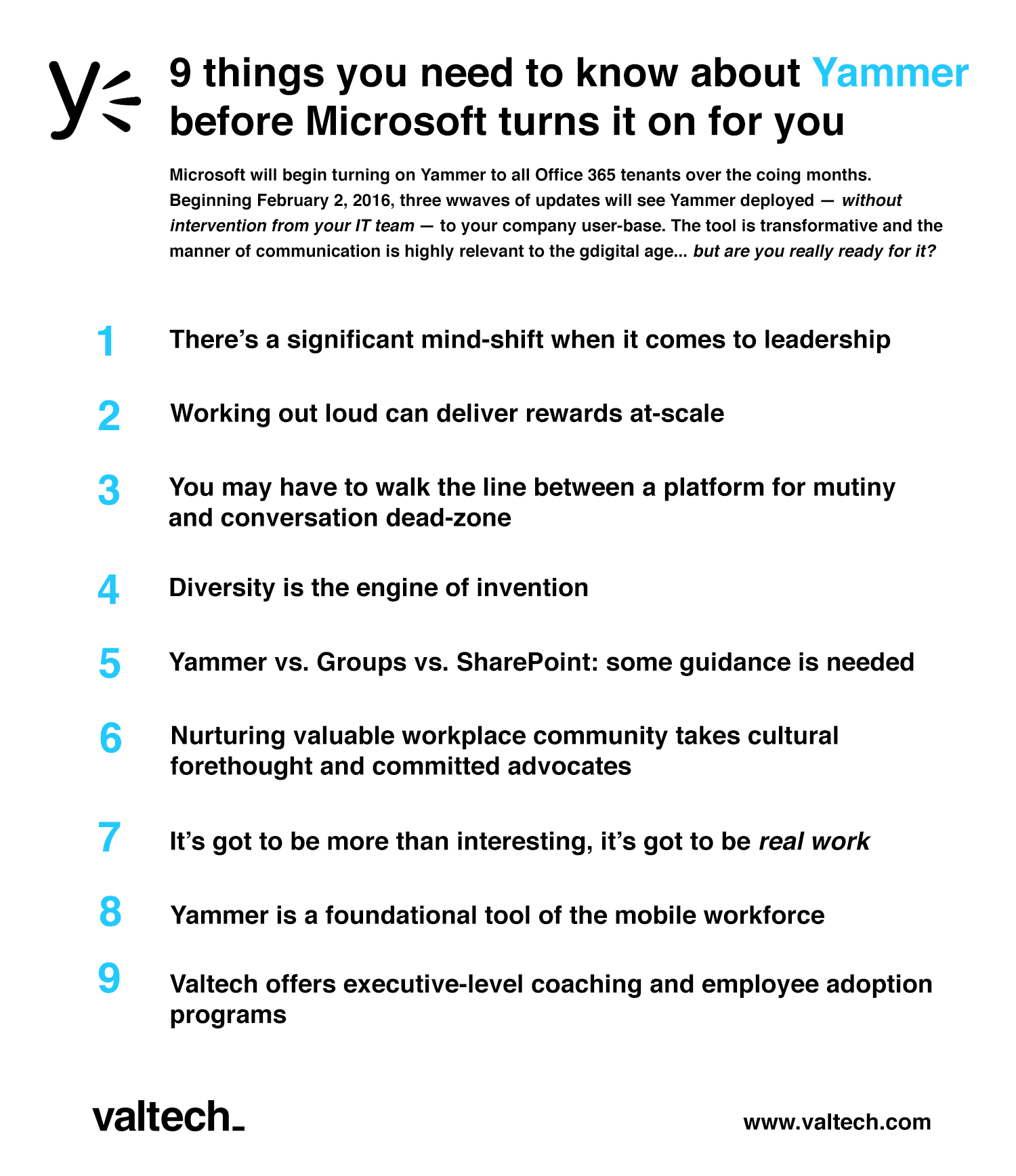Yammer took the enterprise world by storm in 2008, reaching colossal adoption in a very short timeframe. In 2012, the product was acquired by Microsoft and integrated into the Office 365 suite of products.
In many ways, Yammer resembles other familiar consumer-oriented social networks like Facebook or Twitter. A threaded activity feed is the central element. Conversations take place in Yammer Groups and can be directed to the attention of key individuals. Participants can “Like” conversations and upload files or images. Yammer is rapidly becoming the tie that binds Office 365; the social glue that connects experiences such as Delve, Groups, SharePoint, Office 365 Video, Planner and Skype.
On Tuesday, February 2, Microsoft announced the roll-out of Yammer to all Office 365 customers – without intervention from your IT team - in three waves:
Wave 1 starting February 2 to Office 365 customers with a business subscription who purchased fewer than 150 licenses that includes Yammer and who have zero or one custom domains for Yammer.
Wave 2 on March 1, 2016 to Office 365 customers with a business subscription who purchased fewer than 5,000 licenses that includes Yammer. This does not include customers with an education subscription.
Wave 3 starts on April 1, 2016 to all remaining customers with a business subscription and all customers with an education subscription.


9 things you need to know about Yammer before Microsoft turns it on for you
So the question is – is your organization ready for Yammer? We’ve compiled this list of our most significant learnings from the field.
1. There’s a shift in mind-set when it comes to leadership
One of the most momentous transformations occurring in the business world is the move away from rigidly hierarchical organizational structures to a more highly networked model. The hierarchical org-chart, largely a product of the industrial age is efficient but slow when it comes to disseminating communications, fostering innovation and enacting change.
Yammer facilitates an accelerated flow of communication that is arguably a necessity for the digital age. With tools like Yammer, senior management has instant access to the eyes and ears of the front-lines. Good ideas can emerge without the need to pass through the gauntlet of the chain of command. This is a very good thing if your modus operandi is speed and adaptability. That said, middle management - essentially the chain-of-command that gets bypassed - will not be thrilled with the prospect eroding their position as gate-keeper of corporate knowledge. There is a potential that they will resist the transition and inhibit the flow of communication.
Leading a company using Yammer takes a different tack than was previously possible in a command-and-control culture. The medium demands authenticity and humility. Ghost-writers or highly polished communiques have no place in Yammer. Instead, leaders should strive to listen, ask questions, encourage model behavior and rationalize vision through ongoing interactions but without squelching the nascent dialogue.
2. Working out loud can deliver rewards of scale

Adaptability is perhaps the most significant attribute that companies must embrace in the digital age. The exponential pace of technological change requires a vigilant commitment to ongoing learning and development – especially for knowledge workers.
Working out loud, a practice of narrating one’s work and showing the evolving products of that work has the potential for creating shortcuts across the enterprise. Work in this style becomes ambient. As you work out loud, you are focused on your immediate tasks but tangentially aware of the work of others unfolding around you. Think of your work in the way you might approach watching your kids at the swimming pool, you are focused on your kids but somewhat conscious of the happenings around you. If something happens at the pool that grabs your attention you can switch focus. The biggest benefit of working out loud, in my opinion, is when you become aware of similar or complimentary work emerging from elsewhere within the organization. This provides opportunities for reducing the incidence of duplicated efforts or strengthening the products of work through collaboration.
3. You may have to walk the line between a platform for mutiny and conversational dead-zone

We’ve seen some reticence from our customers on the use of Yammer: management sometimes fears the possibility of toxic, unfettered criticism and shies from participating actively. Without the participation of management, however, the legitimacy of the channel is undermined. Essentially, no-one wants to participate if no-one’s listening and there’s little chance that important feedback or ideas will be addressed. Without management’s participation, the value of the enterprise social network is never fully realized.
Before Yammer is made available within your company, it’s important to consider how to foster a positive and constructive conversational tone, how to involve management early and what to do if conversation takes a dark turn.
4. Diversity is the engine of invention

Justin Trudeau very eloquently said at the 2016 World Economic Forum:
“Diversity is the engine of invention. It generates creativity that enriches the world.”
Being around people who are different from us make us more creative, more diligent and harder-working. Why? Because we have to expend extra effort to justify our ideas to people who may have different perspectives, says Scientific American. Diversity of race, ethnicity, gender, sexual orientation and experience amid working groups “forces group members to prepare better, to anticipate alternative viewpoints.” Researchers at Temple University have found that diversity of perspectives within R&D teams are more effective at developing successful products that serve global markets.
A little friction can actually be a good thing – and we have argued before that tools like Yammer can be instrumental in surfacing innovations that benefit the company… and maybe even disrupt the industry.
5. Yammer vs Groups vs SharePoint Teamsites: some guidance is needed

Right now there are a few places where conversations can take place across Office 365. What should go where? Does it make sense to have so many channels of conversation and collaboration? How can employees keep up?
I really like Harold Jarche’s take on working and learning out loud. He sees community as somewhat of a spectrum: moving from highly structured deadline-driven collaboration (like you might do on a work project) to free-flowing cooperation within the participant’s network (this network is not only limited to co-workers.) While I think Yammer can be structured and used across Jarche’s spectrum – I think it’s most natural fit occurs towards the upper-right hand side of the progression – towards cooperation… towards serendipitous insight. Groups and SharePoint Teamsites lend themselves well towards the lower end of the spectrum of focused, deadline-oriented work.
6. Nurturing valuable workplace community takes cultural forethought and committed advocates

Consumer-oriented social networks succeed in-part because there is a degree of trust in the people you choose to add to your network. Amid your highly curated set of friends and family, you can be more at-ease with being yourself and sharing.
Work is different.
At work, you don’t choose the members of your network. There is camaraderie, but there’s also competition and judgement. There may be the perception that we think differently from our co-workers and that they do not share our private opinions. As a result, we feel the need to craft our image more carefully... more selectively. Participation in a social network at work can be seen as somewhat of a risky undertaking.
Who will read what you post? How will it be interpreted? What might happen behind your back? Could it negatively impact your livelihood? Your career? Is participation worth the risk? Or, for that matter, the effort?
Organizations can’t break through to competitive advantage because the conversation naturally veers towards “the safe topics”. This gravitational pull means Yammer never reaches its potential to become a space to formulate and recombine ideas, question the status quo, identify opportunity and refine vision. It is possible to build this kind of commitment to sharing, critique, learning from failure into company culture… but it takes a concerted effort, not a laissez-faire build-it-and-they-will-come kind of approach. I really like how Pixar fostered collective creativity through relentless questioning of their product – a lot can be learned from their approach to collaborative culture.
7. It’s got to be more than interesting, it’s got to be real work

With the deployment of a social network like Yammer, there can be a swell of interest in the first months; but without some help, that interest wanes. At first, participants approach Yammer in the same way they treat consumer social networks (albeit guardedly): sharing a few articles, photos and the like. With time, this devolves as it lacks immediate relevance to our daily work. Even worse, participation in the social network may not be perceived by workplace peers as a legitimate use of time… a distraction from “real work.”
This is a big hump we must learn to overcome. Andy Jankowski offered an approach that sidesteps this denouement of participation. He suggests that rather than personal relationships, “work objects” should be the glue of the enterprise social network. The focus of participation in Yammer becomes about co-creating materials – documents, presentations and the like. Real work! My own view is that there is a balance to be struck… an appealing network is one that is both innately human (interesting, fun, emotional) and productive with “real” work.
8. Yammer is a foundational tool for the mobile workforce
Despite the fact that mobile users now exceed desktop users, becoming a truly mobile-workforce is still elusive to many. Legacy systems and policies hinder access. Considering a hybrid approach with on-premise systems is one way to ease in to mobile. Office 365 is designed from the ground-up for mobile-use. Key experiences are spun off into apps – Yammer being one of the most prolific.
As your adoption program is being planned, don’t forget to inform and educate your employee-base about the Yammer app: Where to find it, how to use it.
Embracing broad use of the app means increasing the readiness and availability of your enterprise social network and should fuel usage. Whether you’re sitting on the train on your commute home from work, standing in-line at the cafeteria, or just waking up in the morning – the app makes it easy to follow and contribute to evolving conversation.
9. Valtech offers executive-level coaching and employee adoption programs
About two weeks ago, Microsoft laid off their team of Customer Success Managers (CSM). The role of these CSMs was created by the Yammer team prior to the Microsoft acquisition in order to help guide adoption of the product. Speculation as to what these layoffs meant for the future of the product itself ran the gamut – from proclamations of the death of the product to the more moderate view that the CSMs never quite fit in with the Microsoft way.
My own belief – particularly in light of Microsoft’s push of the product – is that Yammer is here to stay and will only become more integral to the Office 365 experience.
Despite the gap in support from Microsoft team, the Valtech team provides executive-level coaching and user-centred models for building broad-reaching adoption.
Contact us for more information.





